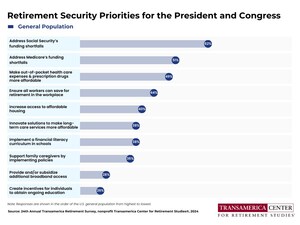LOS ANGELES, Dec. 19, 2019 /PRNewswire/ -- Today's workers have saved $50,000 (estimated median) in all household retirement accounts, but savings vary dramatically across demographic segments, according to A Compendium of Findings About U.S. Workers, a new report released today by nonprofit Transamerica Center for Retirement Studies® (TCRS).
Workers with an annual household income (HHI) of $100,000 or more have saved $222,000 (estimated median) in all household retirement accounts, compared with $47,000 among those earning $50,000 to $99,999. Among those earning less than $50,000, total retirement savings is significantly less— just $3,000. College graduates have saved $160,000, compared with $23,000 among non-graduates. Men have saved $76,000, compared with $23,000 among women.
As part of its 19th Annual Retirement Survey of Workers, one of the largest and longest-running surveys of its kind, TCRS surveyed more than 5,100 workers of for-profit companies. The Compendium offers more than 30 key indicators of retirement readiness among workers by employment status (full-time, part-time), generation, gender, household income, level of education, and ethnicity.
Five Ways to Improve Retirement Security
"Many U.S. workers are continually at risk for not achieving a financially secure retirement. Policymakers are taking action to strengthen our retirement system, by expanding access to employer-sponsored workplace savings plans and making it easier for workers to plan and save," said Catherine Collinson, CEO and president of Transamerica Institute and TCRS. "It is also imperative that policymakers begin devoting attention to addressing Social Security's projected funding shortfall."
The survey findings yield opportunities for improving retirement security, many of which are further supported by TCRS' most recent survey of employers. Five specific opportunities include:
- Expand access to workplace retirement plans. Only 65 percent of workers are offered a 401(k) or similar plan, including 71 percent of full-time workers and just 45 percent of part-time workers. Expanding coverage among both full-time and part-time workers can increase retirement savings rates and provide access to tax-advantaged savings, institutional investments, and the tools and resources that are included with employer-sponsored retirement plans.
- Encourage wider adoption of automatic enrollment by retirement plan sponsors to increase participation rates among workers. Among those currently offered a 401(k) or similar plan by their employer, plan participation rates are lowest among part-time workers (58 percent) and workers with HHI of less than $50,000 (59 percent). Automatic enrollment is a plan feature that can increase participation by eliminating the decision-making and action steps usually necessary for employees to enroll in and start contributing to the plan. Employees are automatically enrolled into the plan with the ability to opt out and stop contributing.
- Discourage "leakage" from retirement accounts in the form of loans and withdrawals, which can severely inhibit the growth of an individual's long-term savings. Almost one in three workers (29 percent) have taken a loan and/or early withdrawal from retirement accounts. Generation X (32 percent), full-time workers (31 percent), and workers with HHI of $50,000 to $99,999 (31 percent) are slightly more likely to have done so.
- Raise awareness of the IRS Saver's Credit, a tax credit that is available for low- and moderate-income workers who save for retirement in a 401(k) or similar plan or IRA. Paradoxically, awareness of the Saver's Credit is lowest among those more likely to meet its income eligibility limits. Only 29 percent of workers with HHI of less than $50,000 and 29 percent of women workers are aware of the credit.
- Implement reforms to Social Security to ensure that it is sustainable for future generations. More than one in four workers (28 percent) expect to rely on Social Security as their primary source of income in retirement, including Baby Boomers (42 percent), those with HHI of less than $50,000 (40 percent), non-college graduates (35 percent), and women (32 percent).
"By addressing demographic disparities, policymakers in collaboration with employers, industry, nonprofits, and academics can help bridge inequalities and improve retirement security among all," said Collinson. "Collective actions taken today can lead to better outcomes tomorrow."
A Compendium of Findings About U.S. Workers and other retirement research and educational tools can be found at www.transamericacenter.org. Follow TCRS on Twitter @TCRStudies.
About Transamerica Center for Retirement Studies
Transamerica Center for Retirement Studies® (TCRS) is a division of Transamerica Institute®, a nonprofit, private foundation. Transamerica Institute is funded by contributions from Transamerica Life Insurance Company and its affiliates and may receive funds from unaffiliated third parties. TCRS and its representatives cannot give ERISA, tax, investment, or legal advice. This material is provided for informational purposes only and should not be construed as ERISA, tax, investment, or legal advice. For more information, visit www.transamericacenter.org and follow TCRS on Twitter at @TCRStudies.
About the 19th Annual Transamerica Retirement Survey of Workers
The 25-minute online survey was conducted within the U.S. by The Harris Poll on behalf of TCRS between October 26 and December 11, 2018, among a nationally representative sample of 5,923 full- and part-time workers, including self-employed. This report is based on 5,168 full- and part-time workers who are not self-employed and who work in a for-profit company with one (1) or more employees. Results were weighted where necessary to bring them into line with the population of U.S. residents age 18+, employed full- or part-time in a for-profit company with one (1) or more employees, and to adjust for attitudinal and behavioral differences between those who are online versus those who are not, those who join online panels versus those who do not, and those who respond to surveys versus those who do not. No estimates of theoretical sampling error can be calculated.
206954
Contact: Kristin Elia
[email protected]
206-576-5502
SOURCE Transamerica Center for Retirement Studies

WANT YOUR COMPANY'S NEWS FEATURED ON PRNEWSWIRE.COM?
Newsrooms &
Influencers
Digital Media
Outlets
Journalists
Opted In





Share this article